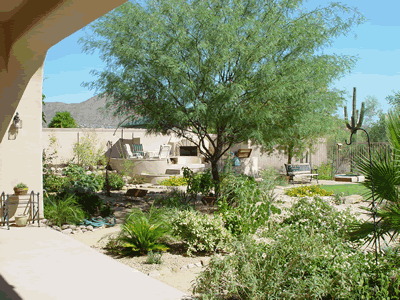Layout
Use graph paper to draw a plan (a scale of 1/4 inch to 1 foot works well). Measure the site's boundaries, house perimeter, and any other existing structures. Indicate north on the plan. Note locations of access to the yard such as doors and windows. If you have gutters, indicate where they drain into the yard. Pencil in existing plants that will remain as well as patios, sidewalks, and the location of irrigation valves. You can use tracing paper over graph paper to try out different possible designs.
Pay close attention to utilities, property lines, and setback lines or restrictions (areas where city and county codes dictate no permanent structures are constructed).
| 1. | Permanent structures such as decorative walls, retaining walls, fences, and trellises may require a permit for construction. Check with your local Planning Department for codes and restrictions. |
| 2. | Pools and hot tubs require safety fencing. Check with your local Planning Department for codes and restrictions. |
Choose a landscape theme:
Sometimes a theme can make a design easily fall into place. The architecture of your home and your lifestyle should influence the look of your landscape. Will your landscape be formal or informal? Whether you choose a native desert, Mediterranean, tropical, or rustic theme, you can incorporate Xeriscape principles by utilizing low-water-use plants. Look to nature for inspiration.

Photographer: Christina Bickelmann
This informal yard takes advantage of harvesting rainwater by having depressed planting beds. Rocks and small boulders help define walking paths and a colorful seating area invites to you relax.
Consider the following when laying out the garden:
Will the space be primarily used for relaxation? Are you mainly concerned with ease of maintenance and “curb appeal”? Is a play area needed for children? Do you have pets? If you intend to entertain, think about space for a patio and barbecue. A major consideration in our desert climate is respite from the summer heat. Shade trees, arbors, ramadas, and patio umbrellas can provide this. If you wish to attract wildlife to your landscape, you'll want to offer food, shelter, and water. If you plan to install an herb or vegetable garden, be sure to locate it in an area with at least 8 hours of sunlight a day. Place compost bins in a shady location within reasonable distance from your kitchen.

This back yard provides shade and places to explore.
Providing generous width in your planting areas ensures that plants will have enough room to grow to their mature size. This will relieve you of the added maintenance of continually having to cut plants back, and will maintain the integrity of the plant’s natural shape.
Consider any areas of your landscape you would like to screen for aesthetic or privacy reasons. Screening can be accomplished in several different ways:
1. A row of trees can create definition and add seasonal color throughout the year.
| 2. | Low shrubs and fences direct the eye, create outdoor rooms, and restrict foot traffic. |
| 3. | Tall narrow shrubs and gentle mounding work well as exterior partitions for outdoor rooms where you desire complete privacy or to block out an unattractive view. |
Do a trial run for your design:
If you are having trouble drawing what your prospective garden plan might look like, try out your ideas in your landscape. Tall stakes can stand in for trees or for elements such as an arbor. Large pieces of cardboard can indicate paving or decks. Strings or garden hoses can outline paths, borders, and garden rooms. Leave the stakes, cardboard, and hoses in place for a few days to see how they influence traffic patterns, views, privacy, and access; you’ll see whether your plan needs any adjustment.